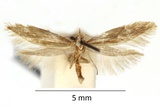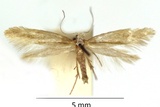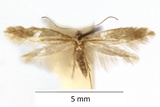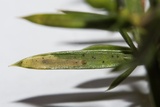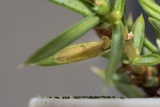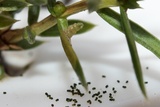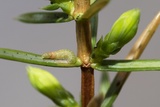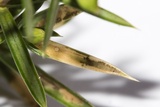Argyresthia aurulentella Stainton, 1849 Species
Last modified: Jan. 5, 2025, 2:53 p.m.
A very rare and local species in Belgium, only occuring in LG.
Details
- Classification
- Family: Argyresthiidae > Genus: Argyresthia > Subgenus: Argyresthia > Species: Argyresthia aurulentella
- Vernacular names
- Gestreepte pedaalmot (NL)
- First mention in Belgium
- Janmoulle E. 1954a. Espèces nouvelles pour la faune belge (suite). — Lambillionea 54: 3–4, 33–34, 57–58. On page 33.
- Status
-
Native
Distribution
Caterpillar
A fully grown caterpillar is 5 mm long, spindle-shaped, greenish in front and reddish in back, both colors merging gradually. The head is shiny black-brown, the pronotum is clouded olive-brown in the middle, with a fine line that widens behind. The back of each segment is divided by a deepened transverse line, which makes the epidermis appear wrinkled, this fold also appears clearly on the sides as a raised skin ridge.
Cocoon/pupa
The cocoon is net-shaped with beautiful, regular meshes. The pupa is green on the back. The head, wing sheaths, and last segments are yellowish.
Bionomics
The larva very often only partially mines the needles of Juniperus until mid-May. With needles that are completely mined, the hole through which the caterpillar has eaten is found in the middle of the upper side, while it is mined, it spins the entrance opening. The frass lies in loose grains in the top half. When the larva wants to leave the needle, then it gnaws another hole. Needles that are hollowed out, in most cases therefore show two holes, one spun, the other open.
In needles that were only partially mined, one sees only an unspun hole, which served as an entrance and exit. In such needles one usually finds only a small amount of frass, the rest of the frass is probably removed through the opening.
Flight periods
Adults are on the wing from mid-June to early August.
